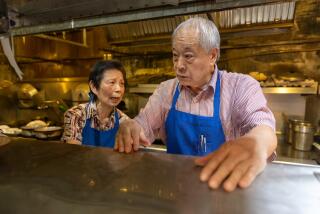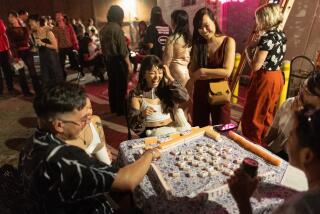CHINA : Playing Match Game With Patterns of Past
- Share via
From a shelf of thousands, James Allen Murphey picks up a Civil War-era covered dish and recites its history.
“It was made by Tresmanher & Vogt in France in 1864,” the 79-year-old Murphey says as he gently turns it over, noting the gold flowers hand-painted atop a delicate design embossed into the white china.
“At the time it was made, there were over 60 factories in that area of France,” Murphey says. “This pattern was probably made until the 1920s. It’s dated because the manufacturers in those days guaranteed their china against impurities for 10 years.”
In this case, it was a casserole dish. But it could have been a plate, a cup, a saucer. Murphey’s business has become a passion after 50 years searching the world for dinner-table furnishings.
Old china has produced a new industry, businesses specializing in discontinued dinnerware patterns. One store that has been around for decades is Murphey’s shop, Patterns of the Past in Princeton, Ill.
If you need a dish, Murphey’s probably got it in his basement, upstairs, even a barn.
“This place is unbelievable,” says Pat Wishop of Rockton, Ill., as she and Karen Swanson pick through hundreds of dishes in the basement catacombs of Murphey’s shop.
The two teachers had driven to Princeton, like hundreds of other china pilgrims each year, in a quest for an obscure, long-ago discontinued pattern.
“I brought a dish that I’m trying to match,” Wishop says. “It’s from a set that my husband’s grandmother owned. They weren’t even sold in stores. Some of the dishes are chipped so I’m hoping to replace them.”
She’s in luck.
Murphey has her pattern, one of a mind-boggling array of china and crystal in all colors, shapes, sizes and styles. They sit floor-to-ceiling on sagging shelves that snake, maze-like, through his modest shop.
Customers bring plates, pictures of dishes, scrap-paper drawings--or they utter vague descriptions of a pattern in hopes Murphey will recognize it.
*
He catalogues in his mind the 12,000 china patterns stored in seemingly wild disarray. Only mental maps exist for most of his stockrooms and barn.
“My father has been here, living this business since the 1940s, and now he gives speeches and teaches classes on it,” says Murphey’s daughter, Jyl Lorenzana.
Murphey says he fell into the business when he was stuck with unsold china inventory after World War II.
“Then he fell in love with this business,” says Winnie Murphey, his wife and co-worker of 50 years.
If Murphey doesn’t have a particular pattern, the real hunt begins.
He will check with some of the 300 importers on both coasts who supply him with china. He may contact china salesmen, dealers or even the factories overseas--many of which he has visited over the years.
Auction houses, flea markets and antique dealers are sources for china, as are other china-matching shops.
The International Assn. of Dinnerware Matchers has about 60 members, said IADM President Iris Freeman in Irving, Tex. But several hundred shops nationwide sell discontinued china patterns. Most are small and carry only certain brands of china or crystal.
“It’s a fairly new industry,” Freeman says. “A lot of people still don’t realize there are businesses that specialize in discontinued patterns.”
Patterns of the Past, about average size among the businesses, has six employees, a client list of 10,000 and average annual sales between $100,000 and $500,000.
Old china is a lucrative business that has exploded in the past five years, says Bob Page, founder of the industry Goliath: Replacements Ltd., in Greensboro, N.C. Its sales jumped from $52,000 in 1981 to $21.5 million last year.
“There’s a huge demand,” says Page, who employs 240 people, has a computerized inventory exceeding 1.6 million, massive warehouses and even a restoration division complete with kilns.
“There’s a sentimentality involved when a bride picks out a china pattern and still thinks it’s the best ever made 25 years later,” Page says. “It’s very personal.”
Unlike Page, Murphey’s approach is stubbornly low-tech.
Customers compete for a single phone line to reach Murphey. Handwritten logs, not computers, track inventory.
And Lorenzana is just getting a facsimile machine installed.
One concession to progress came in 1960 when Murphey entered the mail-order business. Today, it’s a pillar of the business, bringing in about 300 letters a week.
“We aren’t interested in making a million dollars,” Lorenzana says. “We’re interested in personal service--letting customers roam through the basement, get that hands-on experience of finding their patterns. This is exactly what we want, and we’re happy.”
More to Read
Inside the business of entertainment
The Wide Shot brings you news, analysis and insights on everything from streaming wars to production — and what it all means for the future.
You may occasionally receive promotional content from the Los Angeles Times.










